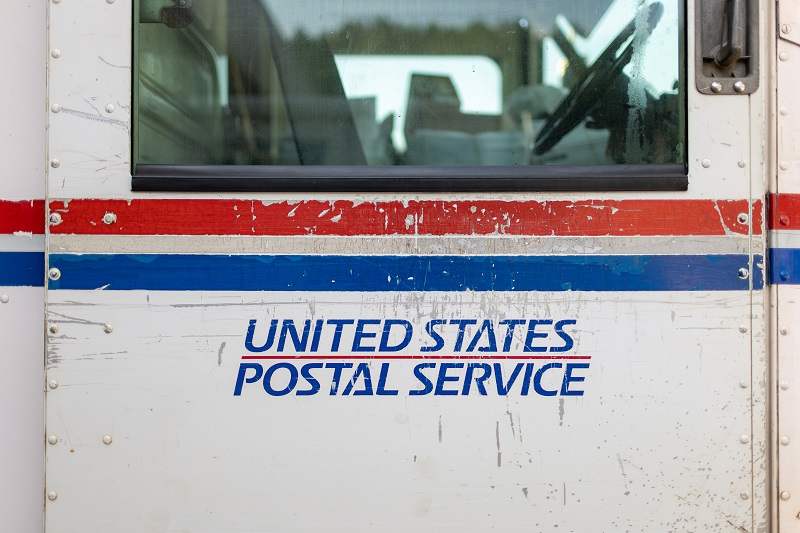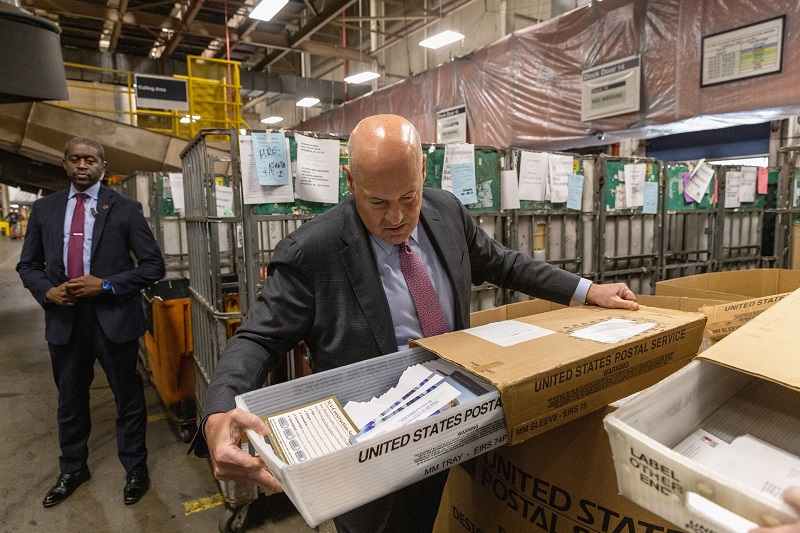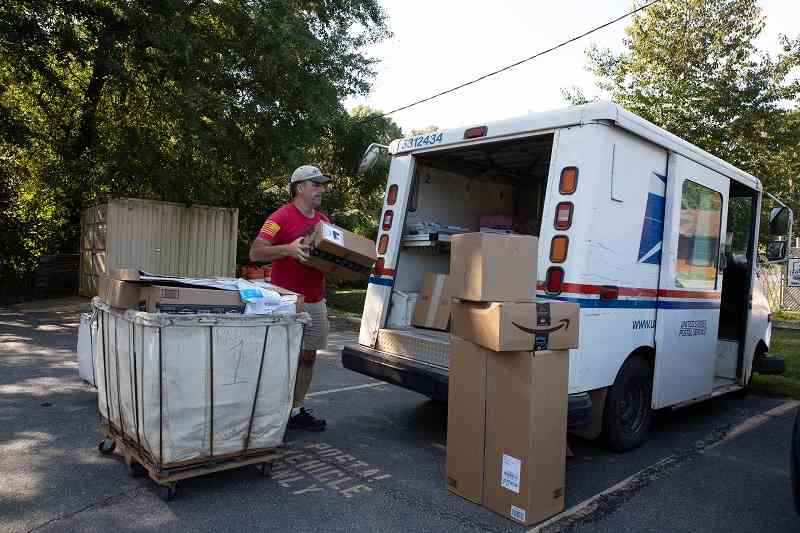
The weathered door of a mail truck in Athens, Ga.
15:16 JST, November 26, 2022
ATLANTA – The grandest experiment of the government’s sprint to electrify its vehicle fleet is happening here, a 1 million-square-foot warehouse leased by the U.S. Postal Service in the outer reaches of Atlanta.
As the White House pushes public agencies and big business to slash greenhouse gas emissions, it is leaning on the Postal Service to step up the pace to meet President Biden’s directive to ensure all new government-owned vehicles are EVs by 2035. And, after a hard-won $3 billion infusion from Congress to jump-start its transition, the first of the agency’s 34,000 zero-emission mail trucks will begin rolling out next year.
Most of those funds, according to Postmaster General Louis DeJoy, will remedy a massive and widely underappreciated challenge in the green migration: the arduous and costly build-out of EV infrastructure, from gargantuan new buildings to thousands of charging stations.
Some congressional Democrats had hoped he would spend the money included in the landmark Inflation Reduction Act to purchase additional EVs instead. The Postal Service’s more than 217,000 vehicles make up the largest share of federal civilian fleet, meaning any significant progress to electrify it would swiftly advance Biden’s climate agenda. And experts say all manner of government entities – from federal agencies to local police departments – will follow a similar process to move away from fossil fuels.
DeJoy said prioritizing infrastructure in the short-term will allow the agency to deploy its EVs more quickly; to do otherwise risked squandering Congress’s investment and undermining mail delivery.
“I can’t put [electric] vehicles everywhere,” DeJoy said. “They need to have homes.”
The agency is set to purchase 85,000 mail trucks, a mix of custom-built Next Generation Delivery Vehicles from a defense contractor in Wisconsin, as well as models from mainstream automakers. Nearly 40 percent of them, roughly 34,000 trucks, will be electric, far fewer than the Biden administration wanted but four times more than the agency initially planned.
The fleet decision was particularly fraught. The House Oversight and Reform Committee vowed to investigate the Postal Service’s truck purchases, an inquiry cut short by Republican victories in the lower chamber in the midterm elections. Sixteen states and two environmental advocacy groups have ongoing lawsuits challenging the Postal Service’s ecological analysis of the trucks. A vendor that lost out on the postal truck procurement sued to stop the deal, then dropped the complaint.
Postal officials hope the EVs signal a new era for the mail service – an institution that predates the United States – just as their precursors had. When the “Long Life Vehicles,” or LLVs, that now crawl U.S. neighborhoods were unveiled in 1987, they were heralded as an engineering achievement that would modernize the mail service and power its growth. DeJoy said the new models, with their outsize windshields and hulking cargo bays, will better position the agency against express shipping rivals Amazon, FedEx and UPS, as well as reinvigorate its mail processing and delivery network.
(Amazon founder Jeff Bezos owns The Washington Post.)
The mission is to make the Postal Service “not just the most trusted” mail and package courier, he said, “but the most used.”
But to get there, DeJoy said, the Postal Service must create a template in Atlanta that can be replicated in 59 other metro areas across the country.
– – –

U.S. Postmaster General Louis DeJoy checks a carrier tray at a facility near Atlanta.
During a late-September visit to that Atlanta warehouse, DeJoy stood with schematics held out before him – letter carriers’ stations in one area, room for hulking new sorting machines in another, ample parking for employees and mail trucks alike outside. He brought The Washington Post along in interviews that included tours of eight Atlanta-area facilities.
Then Postal Inspection Service agents, part of his protective detail, suddenly whisked him away. Shots had been fired by game hunters, several hitting the building while the postmaster was inside. His motorcade peeled out of the warehouse, the truck’s wheels squealing on the clean concrete floor. Order restored, he resumed the tour at another postal building, jokingly ducking and dodging while shaking hands with employees on the workroom floor.
Facilities to accommodate EVs are either brand new or frequently being rebuilt, and logistics companies compete strenuously for top real estate. The Postal Service, unique in its dual role of being a public service and the anchor of the $1.7 trillion mail and package sector, is competing with major corporations to secure scarce EV-compatible resources.
That can hold it back: The resources spent to stay competitive with private express shippers often leave it out of step with the rest of government, said one former postal executive and an executive from one of the agency’s main competitors, both of whom spoke on the condition of anonymity to discuss the industry’s state of play.
“The network is a mess. Facilities are a mess. They didn’t invest for years in facilities,” the former postal executive said. “They have patched things together for years to make it work. It’s important that DeJoy is actively doing things.”
Environmental activists have criticized DeJoy’s restructuring of the agency’s delivery and mail-processing network as a distraction from a more pressing problem: the climate crisis.
Reducing the Postal Service’s carbon footprint – and helping shore up the fledgling commercial EV industry along the way – is more important than the agency’s finances, said Adrian Martinez, an attorney at climate activist group Earthjustice who is leading a lawsuit against the mail service over its vehicle procurement. DeJoy often cites the Postal Service’s chronic balance sheet problems – until Congress overhauled the agency’s finances in March, it was beset by $206.4 billion in liabilities – as an obstacle to full electrification.
“It’s a shrewd approach because he wants to organize his [processing and delivery] network, which is probably unpopular amongst some contingents. And concurrently, he has the super popular thing, which is giving virtually every neighborhood a zero-emission delivery truck,” Martinez said.
“There seems to be a disconnect at the agency that there’s a large desire to go big on electrification of their fleet. Congress sent a signal when it passed the Inflation Reduction Act,” he added. “It’d be more productive if you had leadership from up top, saying, ‘We’re going 100 percent [electric vehicles].’ “
In 2o21, the Postal Service announced that defense contractor Oshkosh would manufacture as many as 165,000 “next generation” delivery vehicles, of which 10 percent would be electric.
The contract was widely panned by Democratic policymakers and environmentalists as insufficient and seen as a rebuke to the Biden administration, which threatened to block it.
In March, the Postal Service increased the EV allocation to 20 percent, citing improving financial conditions, then boosted it again in July to 40 percent, with plans to supplement its Oshkosh purchase through other automakers. DeJoy said the Postal Service will look into a fully electric fleet after evaluating the rollout of its first EVs.
But in an October securities filing, Oshkosh cautioned that it was grappling with engineering and factory build-out delays, as well as “challenges” with recruiting and training new workers. Taken together, the company said, those risks could present “a material adverse effect on our operating performance.”
DeJoy told The Post that he is “leaning” toward using the bulk of the $3 billion from Congress to expedite the EV purchases from Oshkosh and other sellers and install charging infrastructure, rather than expand the proportion of EVs in the fleet.
“It aligns with our strategy, and everything has to align with our strategy,” DeJoy said, “because our main mission is to deliver mail.”
Andrew Mayock, the Biden administration’s chief sustainability officer, said in an interview that the White House is “deeply supportive” of the Postal Service’s progress. “A raising of the bar and acceleration are things that would be expected of an infusion of $3 billion,” he said.
But it’s also emblematic of conversations administration officials are having with other federal entities to help them electrify their vehicles.
“There’s an important organization design concept, more people working together, building managers, energy managers, fleet managers, chief acquisition officers and chief financial officers,” Mayock said. “It’s taking a bigger village to go deliver.”
Nor can the Postal Service lose sight of its primary mandate of mail delivery, DeJoy said. The EV expansion comes as the agency is advancing a new more energy-efficient mail sorting and delivery route structure. All the while, DeJoy is attempting to shoehorn the agency’s aged apparatus – one that’s been steadily overtaken by competitors and made obsolete by changing consumer habits – into a model more in line with the private sector, including those employed by Amazon and the logistics firms he used to helm.
It’s a process that should take five years, he told the agency’s governing board this month. “Without stakeholder cooperation,” he said, “a lot longer.”
– – –

Postal carrier Robert Nagel loads packages onto a mail truck in Winterville, Ga.
“Amazon driver,” reads the handwritten sign taped to the back entrance of the small post office in Colbert, Ga. “Please do NOT leave pallet near the door. You have blocked us in 2 times b/c the pallet is left in front of door.”
The mail clerks have gotten used to diving through an obstacle course of packages to allow letter carriers in to fill up their vehicles. When the loading area by the back door is impassable, mail trucks park in front of the building, taking spots meant for customers.
The pileup of boxes is a mixed bag for the Postal Service. E-commerce has opened a window of economic stability after years of hemorrhaging money due to Americans’ declining mail use. The agency generally supports itself through the sale of postage products, not annual appropriations from Congress like other federal agencies.
But the spike in package volume during the pandemic has at times paralyzed post offices large and small, exposing the weaknesses of stations such as the one in Colbert, a town of 630 where mail is sorted exclusively by hand. The outpost – and hundreds like it across the country – lacks the power to support mail-sorting equipment, let along electric vehicles. DeJoy said he cannot fathom putting EV delivery trucks here.
He can, however, put electric trucks and charging stations 12 miles away in Athens, where the Postal Service is set to consolidate delivery functions from a dozen tiny surrounding post offices.
There’s plenty of power for them and the machine inside that sorts 3,100 packages per hour, still one of the agency’s smaller pieces of equipment. By the time the Athens renovation is complete in 2023, it will house close to 100 trucks, nearly 160 employees, and 83 delivery routes serving 277,000 customers.
Athens, per DeJoy’s plan, will feed even larger facilities in Atlanta, which will commune with comparably sized installations across the country. Most of the rural post offices will remain, but only with retail windows for local customers, not as launching points for daily deliveries. Daily deliveries to smaller communities will originate from nearby larger centralized hubs.
The result, DeJoy hopes, will pull extra trucks off the street and reduce transportation spending by at least 20 percent, a figure that he said is “cutting myself a lot of cushion on what I really think it should be.” In Atlanta alone, the agency has 78 facilities within a 25-mile radius; trucks shuttling mail between those installations are only 24 percent full, the agency said.
“By trying to modernize and get the transportation down is a big, big effort that will produce a big result both in terms of cost and carbon burn,” DeJoy said.
Postal executives say all of these changes are designed to make the agency leaner and more efficient without a noticeable effect on service that reaches 163 million addresses across the country.
DeJoy has jokingly shared two PowerPoint slides with policymakers and agency executives to illustrate the changes he wants at the agency. The first is a screen full of clip-art bats with bold lettering over the top that reads: “This is the worst network I have ever seen.” The bats symbolize “randomness,” he says, a cauldron of flapping wings in the darkness.
The second is a flock of geese flying in a V formation, synchronized and leveraging each others’ wings to conserve energy.
“I don’t want to move a mile,” he says, “unless it’s purposeful.”
"News Services" POPULAR ARTICLE
-

American Playwright Jeremy O. Harris Arrested in Japan on Alleged Drug Smuggling
-

Japan’s Nikkei Stock Average as JGB Yields, Yen Rise on Rate-Hike Bets
-

Japan’s Nikkei Stock Average Licks Wounds after Selloff Sparked by BOJ Hike Bets (UPDATE 1)
-

Japanese Bond Yields Zoom, Stocks Slide as Rate Hike Looms
-

Japan’s Nikkei Stock Average Buoyed by Stable Yen; SoftBank’s Slide Caps Gains (UPDATE 1)
JN ACCESS RANKING
-

Keidanren Chairman Yoshinobu Tsutsui Visits Kashiwazaki-Kariwa Nuclear Power Plant; Inspects New Emergency Safety System
-

Imports of Rare Earths from China Facing Delays, May Be Caused by Deterioration of Japan-China Relations
-

University of Tokyo Professor Discusses Japanese Economic Security in Interview Ahead of Forum
-

Japan Pulls out of Vietnam Nuclear Project, Complicating Hanoi’s Power Plans
-

Govt Aims to Expand NISA Program Lineup, Abolish Age Restriction



















